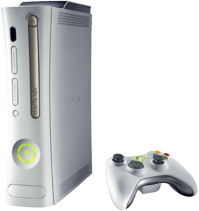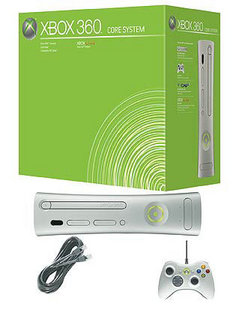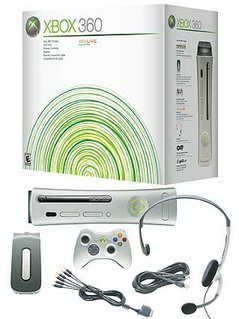XBox 360
The Xbox 360 is Microsoft's successor to their original Xbox video game console, referred to during development as "Xenon", "Xbox 2", "Xbox Next", or "Next Box" . The console was released on November 22, 2005 in North America, December 2 in Europe, and December 10 in Japan. more...
It will be released on February 2, 2006 in Mexico, February 24 in Korea, and on March 2, 2006 in Australia, New Zealand, Hong Kong, Taiwan and Singapore.
The Xbox 360 will compete against the upcoming generation of consoles, including the Sony PlayStation 3 and Nintendo Revolution, and was officially unveiled on MTV on May 12, 2005, a week before E³.
In most countries the console is sold in two different configurations: the "Xbox 360" and the "Xbox 360 Core System". The Xbox 360 configuration, often referred to as the "Premium Edition", includes a hard drive (needed to play original Xbox games and to play live online), wireless controller, headset, ethernet cable, Xbox Live silver subscription, and a component HD AV cable.
The console hardware is based on a custom IBM PowerPC-based "Xenon" central processing unit (CPU) and a custom ATI R500-based "Xenos" graphics processing unit (GPU). It is equipped with 512 MB of RAM and uses the DVD-ROM storage medium for Xbox 360 game software.
Retail configurations and pricing
Microsoft's current retail strategy involves two different configurations of the Xbox 360 in most countries.
In United Kingdom and Europe, the console will be offered in two versions: an Xbox 360 Core System SKU; and an Xbox 360 SKU, frequently referred to as the "Xbox 360 Premium Edition". The Core System will not be available in Japan, instead Microsoft will offer a package identical to the Xbox 360 SKU for ¥37,900 ($343.20). The Xbox 360 Premium Edition is being sold in America for $399.99. Japanese pricing of the console has drawn some criticism, as customers there will be able to purchase the Xbox 360 Premium Edition for a lower price than in other countries.
Microsoft's decision has also allowed Japanese developers to fully utilize the hard drive to optimize game performance, since it is part of the default system configuration in their market. However because of the existence of a Core System edition, many games do not require a hard drive.
BusinessWeek magazine compiled a report which estimates that the total cost of all of the components in the "Premium Edition" is $525 USD, aside from additional manufacturing costs, meaning that Microsoft is losing at least $126 on every Xbox 360 system sold in the US, and at least as much in Japan. The strategy of selling a console at a loss is common in the console games industry, as console makers can usually expect to make up the investment with revenue from game licensing. Also, since Microsoft owns the patents for all custom hardware used in the Xbox 360, they can easily switch to new fabrication processes or change suppliers in the future in order to reduce manufacturing costs. This flexibility stands in contrast to the situation faced by the original Xbox, which contained a processor from Intel (a slightly modified Pentium III) and a GPU from NVidia (a modified GeForce 3). Both of these were very similar to "off the shelf" PC hardware and were therefore sold to Microsoft at inflated market prices. Because of these chips and the added expense of a hard drive component, Microsoft was never able to reduce the cost of manufacturing an Xbox below the break-even point. Microsoft's home entertainment division posted a loss through nearly every quarter of the console's lifecycle as a result. Microsoft hopes to avoid such a predicament with its new console, the company is predicting that a greater market share and falling hardware costs will make the Xbox 360 a profitable venture.
The X-box 360 has become a 'unicorn' in the retail world as gamers search for the elusive console with anger. Many who pre-ordered the system in June of 2005 at various retailers are still without the game system.
It has been rumored that the Xbox 360 may drop its price when the PS3 is released.
Launch details
Dates
The Xbox 360 was officially unveiled on MTV on May 12, 2005, a week before E³. The first area to see the machine released was North America on November 22, 2005, with Europe following just over a week later.
Available titles
Eighteen launch titles were available for customers in the United States on November 22, 2005. The European countries had fifteen titles available for the launch date of December 2, 2005. Japanese customers, however, only had six titles to choose from by the time the Xbox 360 was released on December 10, 2005. This discrepancy is partially accounted for by the time needed to localize the games.
Components and accessories
Controller
The Xbox 360 has the ability to support up to four wireless controllers. Alternately it can support two wired controllers through the use of its USB ports at the front, the USB port on the back will support a third controller. The wired controller has a nine foot (2.74 m) long cord with a break-away feature. The wireless controller has a battery life of up to 25 hours on the NiMH rechargeable battery pack (optional and recommended) and a recommended range of up to 30 feet (9.14 m), although it has been tested to work at a greater range.
The controller for the Xbox 360 is a similar version of the Type-S gamepad for the original Xbox. The Xbox 360 controller adds an Xbox guide button, which has the appearance of the Xbox 360 emblem and is surrounded by a ring of green LEDs. Pressing the Xbox guide button will bring the Xbox 360 out of sleep mode, turn the console on or off, and bring up the "Xbox Guide" for access to digital movies, music and games libraries. The ring of light lights up the quadrant (on the controller as well as the console) that correlates with the quadrant of the screen you will be playing on (if more than one person is playing the game). The black and white buttons have been redesigned as shoulder buttons, now referred to as bumper buttons ("LB" and "RB"), located above the left and right triggers. The rear of the controller includes a port where the player can connect a headset. This port replaces the two non-standard USB connectors on the front of the Xbox controller.
Read more at Wikipedia.org




